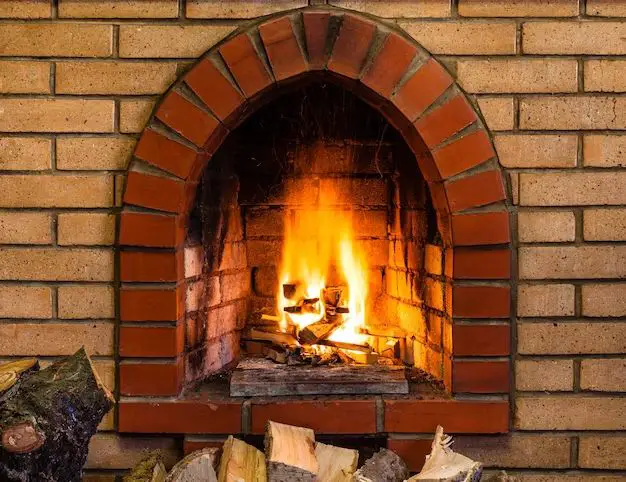Starting and maintaining a nice fire in your fireplace can be a pleasant and rewarding experience during the colder months. With some basic knowledge of fireplace anatomy, an understanding of fire dynamics and airflow, and a bit of technique, you’ll be able to start strong, beautiful fires whenever you want.
Page Contents
What You Need
Before getting a fire going, make sure you have the key supplies on hand:
- Firewood – Well-seasoned hardwoods like oak, hickory or maple are best. Avoid softwoods like pine which can spark dangerously. Split logs will light faster than rounds. Have wood in a range of sizes from kindling up to larger logs.
- Firestarters – Commercial firestarters, newspapers or dryer lint work well.
- Tools – Matches or a long matchstick lighter. Fireplace tools like a poker, shovel, tongs and broom.
Prep the Fireplace
Preparing the fireplace itself is an important first step:
- Check that the flue is open to allow smoke to vent up the chimney. Use a fireplace draft tool to determine air flow.
- Clear away ashes from previous fires if needed. Accumulated ashes can choke airflow.
- Crumple several sheets of newspaper and place them in the firebox to serve as tinder.
- Construct a basic wood tower using kindling. Crisscross larger kindling over the tinder base.
Light the Fire
With your materials and kindling tower ready, it’s time to light the fire:
- Light the tinder at the base of the kindling tower using matches or a long matchstick lighter. Let it catch and burn for 2-3 minutes.
- Gradually add slightly larger kindling pieces to the burning tinder to build up the fire.
- Once the kindling is burning well, begin carefully adding small split firewood logs. Stack them in a crisscross arrangement to allow airflow.
- As the fire builds, continue slowly adding larger logs. Adjust positioning as needed.
- Once the fire is burning strongly, use fireplace tools like a poker or tongs to maintain the stack and airflow as needed.
Troubleshooting
If you have trouble getting the fire lit, here are some things to try:
- Ensure adequate airflow – Check that flue is open and clear any ashes or debris
- Use extra tinder – Add more newspaper, commercial firestarters or other tinder
- Thinner, dryer kindling – Use the driest, thinnest pieces to build up the fire initially
- Check wood condition – Wet, rotted or thick logs will be difficult to light
- Adjust log positioning – Crisscross logs leaving airgaps rather than stacking tightly
Maintaining the Fire
Once your fireplace fire is burning nicely, you’ll want to keep it going strong. Follow these maintenance tips:
- Add wood periodically to reinvigorate the flames as existing logs burn down. 2-3 medium sized logs added at a time works well.
- Adjust log positioning for airlfow as needed. Use fireplace tools to push logs into better positions.
- Let each load of wood burn down before adding more. Don’t smother the flames with too many logs at once.
- Clean out excess ash buildup to maintain airflow to the fire. Let ash cool fully before disposal.
- Keep fireplace doors open while fire is burning to aid airflow.
- Refuel as needed for the desired length of burn. Hardwoods provide longer lasting fires.
Avoid Smoky Fires
To prevent excess smoke when stoking the fire:
- Always open flue before lighting and keep it fully open while fire is lit.
- Burn seasoned, dry firewood. Wet wood leads to more smoke.
- Avoid overloading the fire with too many logs at once.
- Don’t let fire smolder; maintain lively flame.
- Check for adequate ventilation. Open nearby windows briefly.
Safety Tips
Observing some fireplace safety guidelines is also very important:
- Use a fireplace screen to prevent sparks popping out.
- Don’t overload the fireplace which can lead to chimney fires.
- Keep children and pets away from the fire.
- Properly extinguish the fire before leaving the house or going to bed.
- Always use a metal ash bucket to dispose of cooled ashes.
- Have your chimney cleaned and inspected annually by a professional.
What to Burn
For clean, efficient fires, you’ll want to burn the right materials. Here are some guidelines on firewood:
Recommended
- Seasoned hardwoods like oak, hickory, maple, apple, birch
- Dry, split logs with 20% or less moisture content
- Wood seasoned for at least 6 months
Avoid
- Green, unseasoned wood with high moisture content
- Softwoods like pine, cedar and spruce
- Rotted, moldy or painted wood
- Wood burned in an old creosote buildup
Moisture Content Ratings
Here are typical moisture contents for variously seasoned wood, and the effects on burning:
| Wood Type | Moisture Content | Burn Characteristics |
|---|---|---|
| Green wood | 30-60% | Hard to light, smokes heavily |
| 6 months seasoned | 20% or less | Lights easily, burns cleanly |
| 1+ years seasoned | 15% or less | Lights very easily, burns efficiently |
Conclusion
Starting and tending a fireplace fire is a relatively straightforward process but following good techniques makes it easier and safer. The keys are using very dry, seasoned wood, allowing for adequate airflow, starting slowly with tinder and building the fire gradually, and avoiding overloading the firebox. With a properly prepared fireplace and high-quality fuel source, you can easily light beautiful fires to enjoy all winter long.
